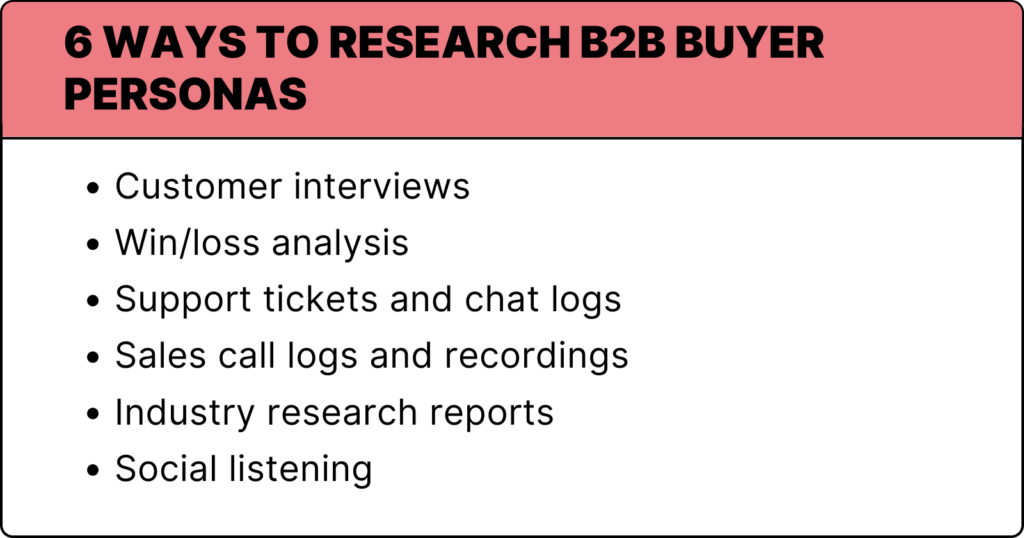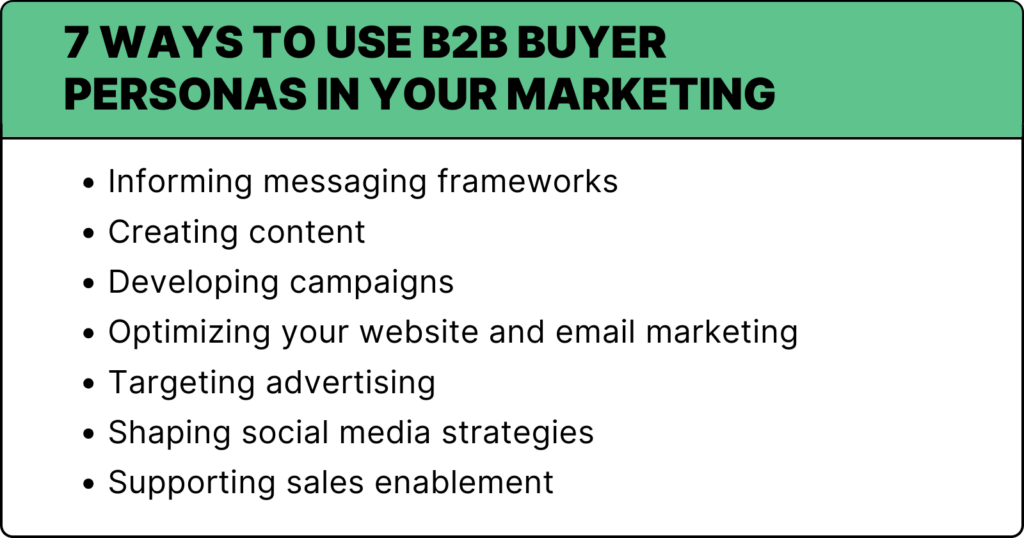B2B buyer personas are an important part of any effective content marketing strategy. These semi-fictional representations of target customers help your brand influence messaging, content creation and product development. They help your content marketing team understand who they’re targeting and what information they need.
Buyer personas in B2B content marketing are especially valuable when your industry is rapidly changing. Technology (and the COVID-19 pandemic) shifted B2B buying to online and mobile in many industries. Meanwhile, boomers are gradually giving way to millennials and even older Generation Z workers when it comes to purchasing decisions. These are just some of the factors that demand a fresh approach to your B2B marketing personas.
This guide will help you understand what B2B buyer personas are, how to create them and how to use them in your marketing and sales strategies.
What Are B2B Buyer Personas?
Buyer personas are semi-fictional, generalized pictures of your ideal customers. They synthesize real data about customer demographics, behaviors, attitudes and motivations into representative profiles. These proxies help humanize target audiences to inform your marketing and sales strategies. With well-written personas, you’ll feel as if you are talking to a real person.
B2B buyer personas are essential for the following:
- Crafting relevant messaging and content that resonates with customers’ needs and preferences.
- Shaping product development to address target users’ goals and pain points.
- Influencing demand-generation campaigns that are customized to different segments.
- Guiding sales conversations with tailored scripts and objections.
Role in Marketing and Sales
Buyer personas align marketing and sales teams by providing a shared understanding of the target customer. This alignment makes collaboration more successful and fuels consistent strategy and messaging throughout the funnel, from awareness to interest and consideration to decision.
Personas are especially helpful for marketing teams as they define content topics, messaging frameworks and campaign targeting. B2B buyer personas also influence which distribution channels your brand pursues, including targeted social media channels and industry publications.
Demand-gen marketers use personas to split broad audiences into segments for tailored outreach that wins over buyers. They map content types and calls to action to each buyer journey stage. This process allows the development of multi-touch nurture campaigns that progressively move leads toward a purchase.
From a sales perspective, well-researched personas highlight common sales objections likely to arise at different stages. Personas influence sales conversations by highlighting likely customer pain points. Reps can use these insights to tailor their pitches and solutions to each persona’s issues — and effectively respond to objections. Armed with personas, their own research and proper training, your sales teams will be more effective, helpful and empathetic during client and prospect interactions.
B2B Vs. B2C Buyer Personas
Just as buyer personas reflect the differences between types of customers, there are also key differences between B2B buyer personas and business-to-consumer (B2C) buyer personas.
For example, B2B buyer personas emphasize the individual in the context of their organization more so than their personal interests or hobbies. Sure, knowing a prospect is a 10-handicap golfer isn’t irrelevant to the savvy salesperson building relationships. But B2B buying involves more stakeholders and longer decision cycles, so company dynamics take center stage.
Specifically, B2B personas differ from B2C in four areas:
- B2B buying decisions involve multiple decision-makers, often across titles and functions. B2C purchases are often an individual decision, or one or two individuals making a decision for a family
- B2B sales cycles are typically marathons compared with B2C sprints. There are relatively few impulse buys in B2B compared with consumer spending, although there are always exceptions.
- B2B priorities are less likely to be emotionally based — think technical specifications, product capabilities, integration with existing systems and workflows, and so forth.
- B2B buyers want post-sale service more often than B2C buyers. How will your brand not only deliver a product or service but also support the buyer during implementation and beyond?
Make sure you understand what type of customers you’re pursuing and whether you need B2B personas, B2C personas or a mixture of both. Content marketing for startups, for example, often requires targeting consumers and business buyers simultaneously — although not necessarily with the same services, pricing structures or revenue models.

6 Ways to Research B2B Buyer Personas
Detailed, practical B2B personas rely on an orchestrated process of research, analysis and synthesis. You’ll want to define your target audience based on industry verticals, company sizes, job titles and duties, and decision-making roles, among other characteristics.
Here are some ways to gather the qualitative and quantitative data you need to develop B2B buyer personas.
Customer Interviews
Customer interviews are crucial for understanding the target market. Engaging in conversations with prospects, current clients and even lost accounts can uncover vital information about customer priorities, decision-making considerations and how customers perceive your competitors. Ask open-ended questions that encourage detailed responses to gather deeper insights. (Your product managers can use interviews to keep everyone aligned on target users, too.)
Win/Loss Analysis
This approach involves examining the reasons behind successful and unsuccessful sales efforts. By comparing the factors that contributed to wins and losses, you can identify buying process patterns and obstacles. Additionally, analyze buying committee dynamics and the sales cycle’s length and complexity. This information is critical for refining sales strategies and identifying the most compelling selling points.
Support Tickets and Chat Logs
Analyzing customer support interactions can reveal common problems, such as gaps in your product or service offerings. This direct feedback helps identify real-world customer issues. Whether the root cause is in your customer service, marketing strategy, product quality or something else, this data can help companies address these issues or target a different type of customer.
Sales Call Logs and Recordings
Reviewing sales logs and recordings offers insights into the customer’s level of understanding and interest, the language they use to describe their needs and the key factors they consider when deciding. This information is valuable for training sales teams and developing sales enablement materials that resonate with prospects.
Industry Research Reports
Industry reports, whether from giants like Gartner or Salesforce or from thought leaders in your industry, offer a macro view of growth factors, technological disruptions, regulatory changes and emerging trends. Such data helps ground buyer personas in the broader market context and can inform long-term strategic planning.
Social Listening
Tracking the web and social media channels for mentions of your brand, competitors and industry keywords can provide real-time feedback on public perception and emerging trends. This activity can influence content creation, reveal customer pain points and highlight where your products or services are beloved — or causing frustration.
6 Elements of B2B Buyer Personas
With research insights in hand, it’s time to divide your market into segments and build persona profiles to enable data-driven content marketing. Here are some of the essential elements of B2B buyer personas.
Objections
Documenting common objections encountered during the sales process helps your sales team develop counterpoints and reassurances. Understanding these barriers — whether they concern pricing, technical limitations, integration issues or something else — allows for more effective sales training and content creation that addresses these concerns head-on.
Journey Mapping
Mapping out the typical B2B decision-making journey helps understand the stages your potential customers go through before purchasing. These stages include initial research, internal discussions, budget approvals and trialing products. Understanding these milestones — and which ones your particular persona will engage with — can inform targeted content that guides prospects through the sales funnel that makes the most sense for them.
Demographics
Demographic details such as industry, company size, location and job title are essential for audience segmenting and tailored messaging. This can take the form of automated targeting, journey pathways, the language you use in your advertising and how you craft and position content. Whether you’re creating content marketing or qualifying leads, you want to reach the right stakeholders.
Goals and Challenges
By identifying target customers’ strategic goals and immediate challenges, you build a framework for messaging that resonates with them. Whatever the needs your customer persona faces — growing the business, becoming more efficient, reducing risk, innovating — understanding these objectives can inform content that appeals to their aspirations and offers solutions.
Day-to-Day Activities
Knowing target customers’ daily routines and responsibilities can help create content that fits naturally into their workflow. Highlighting the essential systems they use, the meetings they attend and their professional responsibilities allows for a more integrated and relevant content strategy. Leverage B2B buyer persona templates to maintain consistency across profiles. Construct enough detail to influence messaging and content tailored to each one directly.
Validate and Refine
You probably won’t get each persona right the first time. Be ready to refine details that don’t resonate or make sense. Be prepared to fill in missing insights through real-world testing. Personas change over time, such as when a prospect becomes a recurring buyer, so make sure you’re ready to audit and adjust personas so they continue informing your sales and marketing efforts.
B2B Buyer Persona Examples
There’s more than one way to construct B2B buyer personas. Below are just two examples: The first is succinct and relies on bullet points, and the second is a narrative that’s conversational. Either approach can work in the right circumstances.
Format isn’t necessarily as important as function. As Marketing Interactions Inc. CEO Ardath Albee told us, “B2B buyer personas are done right when they provide marketers with the insights, knowledge and understanding they need to continuously reach and engage their buyers and customers with their marketing strategy and programs.”
Let’s look at these examples.
Tech-Savvy Steve
Background: 35, works as a senior product manager in the software development industry. His company has 200-500 employees and is based in Urbana, Ill.
Goals:
- Streamline product development cycle
- Incorporate user feedback into product features
- Stay ahead of market trends and technological advancements
Challenges:
- Balancing feature development with timely product releases
- Gathering actionable user feedback
- Prioritizing product roadmap with market needs
Steve’s Behavioral Traits:
- Engages with industry thought leaders on LinkedIn
- Attends tech conferences and webinars regularly
- Prefers consuming content through industry reports and technical blogs
Decision-Making Role:
- Influences final decisions on product development tools and software
- Leads a team that evaluates the technical viability of new features
- Collaborates with C-suite on aligning product strategy with business objectives
Content Preferences:
- In-depth technical guides
- Case studies from similar industries
- ROI-focused whitepapers
Sales Engagement:
- Responds to data-driven pitches
- Seeks trial versions before making purchase decisions
- Values long-term partnerships over one-time vendors
John Smith
John is the digital marketing director at a 250-employee B2B SaaS company focused on marketing analytics solutions. He is 38 years old and has a marketing degree and an MBA.
John is responsible for the company’s strategy to generate qualified leads and new-business opportunities. His main goals are growing the marketing department’s contribution to revenue and cementing the company’s reputation as an innovator.
John oversees paid search and social campaigns, as well as monitors the company’s content marketing and email nurturing efforts. He manages a small team focused on website optimization, digital ad buying and campaign reporting. John also regularly engages with the sales team to provide quality leads and identify areas that marketing can support.
John’s challenges include converting multichannel data into a single view of the customer journey. He wants deeper attribution insights from campaigns and to expand content personalization. Resources are limited, so John seeks marketing platforms that unify data and provide actionable analytics.
When evaluating vendor solutions, John has three main objections: total cost of ownership across software, staff training, and concerns about platforms fitting the company’s tech stack and culture. He attends martech conferences to get a better understanding of product capabilities and road map vision and long-term viability.

7 Use Cases for Buyer Personas in Your B2B Marketing Strategy
Once you’ve researched, assembled and validated your B2B buyer personas, you can apply them across an array of marketing and sales functions. Here are seven use cases (and you’ll likely find other uses that meet your business goals).
Messaging Frameworks
Effective messaging frameworks are designed to resonate with each persona’s unique goals and pain points. By crafting positioning statements that align with a persona’s objectives, you write a narrative that speaks directly to them. Look for slogans and messaging hierarchies that reflect each persona’s specific language and priorities. This helps them feel that you’re communicating directly with a personalized, relevant message.
Content Creation
B2B buyer personas help content marketing teams create targeted content for key audiences — even down to the specific stage of their customer journey. For example, you can write SEO-optimized informational articles for a persona while they’re in the awareness stage.. Your team can host webinars or create downloadable how-to guides to meet prospects in the interest and consideration stage. Customer success stories for each persona, meanwhile, can be influential as the prospect enters the decision stage.
Campaign Development
Targeted campaigns are most effective when they include calls to action that cater to the persona’s stage in the buying process. These campaigns are more effective when you have well-defined, validated personas, as everyone in the company knows who is being targeted and can shape the campaign accordingly.
Website and Email Optimization
Your website can cater to different personas by segmenting content and creating clear conversion paths for each group. For example, you can create persona-based landing pages that address specific needs or questions and guide visitors toward a tailored action. Combine this website optimization with your email marketing software to amplify the effect. One of the biggest email marketing mistakes is failing to segment your subscribers; do so intelligently by mapping your list against personas.
Advertising
As you personalize landing pages, make sure you’ve aligned ad creative with personas so you get the right people clicking through and showing interest. Tightening audience targeting parameters ensures that ads are served to the most relevant segments, increasing the chances of engagement and conversion. You’ll also increase ROI from your advertising and potentially lower total spend.
Social Media
Social media remains a powerful set of channels, but finding the right people online and gaining their trust is harder than ever. Marketers can prioritize social efforts by understanding which channels each persona uses most. With social reach increasingly dependent on paid spend and influencer arrangements, targeting is essential to reduce waste and maximize ROI with the right prospects..
Sales Enablement
Sales teams are more effective when they understand the common objections of each persona, the terminology they use, the challenges they face and their typical processes. Combine this intelligence with sales enablement efforts to give sales reps the tools and knowledge they need — including sales scripts, responses to objections, customer testimonials and more.
How to Update B2B Buyer Personas
Markets evolve. Companies change. To keep personas relevant, plan regular maintenance to update profiles. Here are a few ways you can update your personas with confidence.:
Sales Team Feedback
Sales reps engage directly with customers daily. Incorporate their experiences into updated persona objections, process changes and emerging goals.
Automated Reports
Use automation tools and customer data platforms to generate regular insights from behavioral data, chat logs and multi-touch campaign analytics.
Reviews and Interviews
Set quarterly or biannual in-depth persona reviews to realign with stakeholder perspectives and test again directly with customers. Maintain flexibility to account for meaningful market shifts that warrant immediate changes.
Remember that personas aren’t biographies. They’re informed best guesses at who your ideal customers are, what they want and how they behave. Supplement these personas with regular customer interviews to test your assumptions and detect shifts.
“An interview or two every quarter can help you get ahead of changing priorities,” Ardath says, “as well as understand concerns or new obstacles your buyers must overcome.”
Use B2B Buyer Personas to Make Better Content and Close Deals
B2B buyer personas are more than just a tool; they’re an essential element of a successful B2B marketing strategy. While developing and maintaining detailed buyer personas is challenging work, the results can be powerful for your content marketing, sales and business development efforts.
For content marketing leaders, personas help your people understand their target customers while showcasing how tailored content drives engagement and business success.
Subscribe to our newsletter for more insights for modern content marketing leaders.






